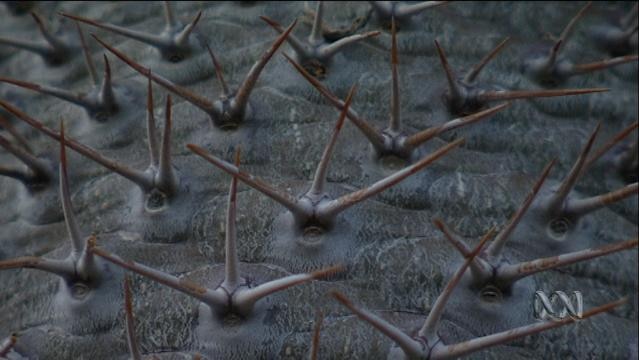An animated frog.
FROG:
Ribbit! Ribbit!
The frog crawls through vegetation. Title - 'Kids in the Garden. Gardening Australia.'
Text on screen - 'Survivors'. Nick Hardcastle walks around with arms outstretched and a blindfold on. He touches a prickly plant and yells.
NICK HARDCASTLE:
Ahhh! Huh?
He imagines his pricked thumb turns into a cactus and gasps.
NICK HARDCASTLE:
Now, you might think that plants are pretty laid-back but, oh, no, my friend. Plants live wild and crazy lives. And they've made endless changes over millions of years to deal with the different environments that they've developed in. So you'll find plants high in the freezing mountains, in the sea and in hot, dry deserts. Plants can take it all. Plants are the great survivors. And they play all sorts of tricks to get what they need.
Visuals of the spines of cacti.
NICK HARDCASTLE:
Plants can't run away from hungry creatures so self-defence is top of the list. Sharp cacti spines are modified leaves that help keep thirsty animals away from their water-filled stems.
He taps a plant.
NICK HARDCASTLE:
Look at the nasty barbs on this calamus palm. Nothing is going to climb up this to get to its leaves and shoots. Just like a beautiful rose has thorns, this is all about protection.
A moth orchid.
NICK HARDCASTLE:
Some plants pretend to look like something they're not. This orchid has managed to look like a moth. It needs to attract moths to spread its pollen to other orchids so that the plant continues to multiply. Living stones grow to look just like smooth little pebbles so they can hide in bare, rocky deserts. Any smart animal would think, 'Why be a rock muncher? I'm better than that!' (Laughs) Suckers! Many plants use amazing hooks and touch-sensitive tendrils to hitch a ride and grow up and over other plants. This strangler fig grows all over an innocent host tree, and steals its food, eventually killing it by strangulation. That's not very nice.
He raises a leafy burger to his mouth. A nearby plant growls at him.
NICK HARDCASTLE:
Back off, buddy! Get your own blowfly burger. These guys are real nasty. They're carnivorous plants, which means they eat meat! Carnivorous plants come from areas where the soil has no food in it, so they get their din-dins by eating insects and other little creatures, and slowly digesting them ALIVE.
He turns to the plant.
NICK HARDCASTLE:
Stop looking at me like that. You can't have any.
Visuals of various plants.
NICK HARDCASTLE:
This sundew uses sticky stuff on its tentacles to trap its victims. The pitcher plant attracts insects with an irresistible sweet smell. Mr Bug falls into the trap and can't get out, slipping into a pool of gooey stuff at the bottom, and is digested by the plant. Mm-mm! Insect soup. These plants can survive in some of the most desolate places on Earth. But could they survive in your bedroom?
A plant closes around an insect.
NICK HARDCASTLE:
Blowflies beware! This is a venus flytrap, and it catches flies and eats them! Just like my friends Cody and Tom.
The camera reveals two children standing near him.
CODY:
I don't eat flies. He does.
TOM:
They're not so bad with a bit of caramel topping.
NICK HARDCASTLE:
Disgusting! Alright, now, the way it works is, the insect lands on these jaws, which triggers little hairs to snap them shut, trapping the bug, and then the juices dissolve the bug and the venus flytrap eats them. Mmm! Yummy.
TOM:
Gross, Nick!
CODY:
Feral!
NICK HARDCASTLE:
Well, we're gonna show you how to make a whole plant out of using just one of these leaves. The first thing we have to do is take it out of the pot.
Fast-motion visuals of the process.
NICK HARDCASTLE:
Peel away the soil to reveal the cluster of leaves. Gently pull the individual leaf away, give it a quick rinse, and pop it into some of this - sphagnum moss. You can get it from your nursery. It's excellent at holding water. And it can be used over and over again. Place the cuttings upright into the pot, about 4cm apart. Sit the pot on a tray of pebbles with some water. Keep it damp. In a few weeks, roots will have developed, and you can plant it in a bigger pot. Now, don't go poking your plant. That's a really dumb idea and could damage it. You might also need to catch a few flies or ants to get started. You any good at catching flies?
TOM:
Not that good, Nick.
CODY:
But I am.
NICK HARDCASTLE:
Alright, well, don't overfeed it. And you might be better off leaving the plant to do its own work. Whatever you do, don't use fly spray. And next time you're munging out on a plant...
He takes a bite out of a plant.
NICK HARDCASTLE:
..imagine if it could bite you back. Ow! Ahh!
Cody squirms.
NICK HARDCASTLE:
Only kidding.
